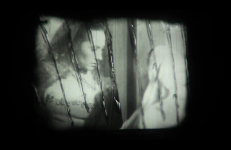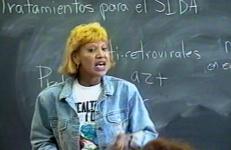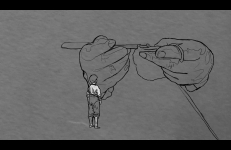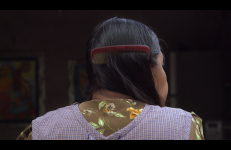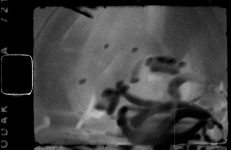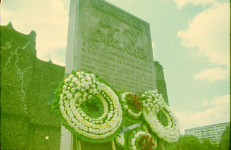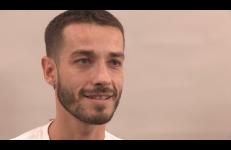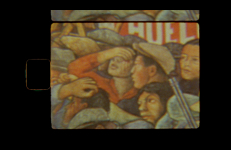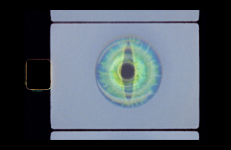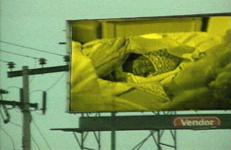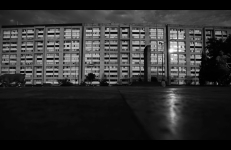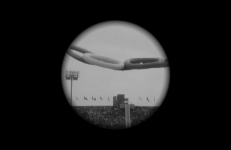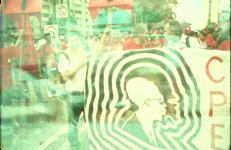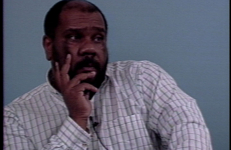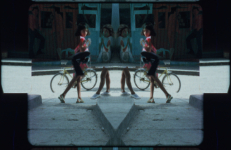I Stare at You and Dream is a slice of life melodrama that journeys to the core of interrelationships. This film juxtaposes and links the lives of four people: the filmmaker, Susan Mogul; her friend, Rosie Sanchez; Rosie’s teenage daughter, Alejandra (Alex) Sanchez; and Ray Aguilar; Susan’s-on-and-off boyfriend. Tender and unflinching, each character gradually reveals their desires, wounds, and romantic entanglements in the context of their everyday lives.
Latino/Chicano
A woman raises her voice and gives a painful and endless speech that with time becomes even more overwhelming, because her words are heartbreaking and permanent impressions in the collective memory, stabbing with words an old Mexican film, a celluloid that tears apart until its disappearance.
This title is also available on the compilation What Was Always Yours and Never Lost.
(In) Visible Women shows the heroic responses of three women with AIDS in the context of their respective communities. In the face of adversity, these women confront all aspects of the AIDS crisis in their lives. Through poetry, art, activism, and dance, they explode notions of female invisibility and complacency in the face of AIDS. We hear each woman describe how she came to terms with being HIV+ and joined others in speaking out about the neglected needs of women.
Alfredo Jaar is a politically motivated artist whose work includes installation, photography and film. Born in Chile and now living in the U.S., Jaar’s socio-critical installations explore global political issues, frequently focusing on the Third World and the relationship between consumption and power. A 1988 installation in a subway station in New York involved dramatic photographs of impoverished gold miners n Brazil interspersed with quotations of current gold prices, drawing an unexpected parallel between the material desires that motivate people in both poverty-stricken Br
La Mesa explores the intersections of memory, identity and queer desire. It recreates fragmented and romanticized stories of a childhood in rural Mexico as told by the artist’s father. These disjointed vignettes are interwoven with queered reenactments of scenes from popular culture. The artist casts himself in the old Mexican films and American Westerns he grew up watching with his family in California. He appears as the romantic lead opposite the male actors, including Pedro Infante, Mexican national hero and the filmmaker’s childhood crush.
The “greca”, the meander, is the main symbol weaved in the textiles made by the Navarro sisters, from Santo Tomás Jalieza, México. A geometrical form of an endless braid of diamonds, the “greca” represents corn (an entity worshiped by the pre-hispanic civilisations of Mesoamerica). It stands for sustenance, but materialises as well the feminine power of producing abundance and fertility - the textiles displaying this ongoing motives could be read as invocations for life and growth.
Guillermo Gómez-Peña, Gustavo Vazquez, Daniel Salazar, Patrick Litchy, Jethro Rothe-Kushel
In La Lucha (the fight), families struggle to cope with frequent deportations and the constant threat of INS sweeps that, in the end, completely dismantle the community. Following up two years later, Hock reports their triumphs and setbacks. The video ends with hope—but no real promise—of a brighter future for those living on the unrecognized margin of society.
This title is also available on The Mexican Tapes: A Chronicle of Life Outside the Law
Lumbreras is the historical and archeological place of the bones, ruins and detritus. A window thought time, an ancestral rhythm of the audiovisual materials.
A political composition on natural resistance. These images are an expiring breath in danger of extinction. These images become extinguished, consumed: a drop, a pure intensity which only appears when falling. In the presence of the image these audiovisual crowds become an affected body, assaulted by entropy. A face exhausted and reanimated by the continuous sound trance that traverses the battlefield. Faces for an eye that would not need to see.
Performance artist/sculptor Ana Mendieta used the raw materials of nature: water, mud, fire, rock, and grass. The consciousness of her politics and the poetics of her expression fill her work with an emotionally charged vision that is powerfully conveyed in this posthumous video profile. Drawing upon the raw spiritual power of Afro-Cuban religion, Mendieta used her art as a ritualistic and symbolic activity to celebrate the forces of life and the continuum of change.
Performance artist/sculptor Ana Mendieta used the raw materials of nature: water, mud, fire, rock, and grass. The consciousness of her politics and the poetics of her expression fill her work with an emotionally charged vision that is powerfully conveyed in this posthumous video profile. Drawing upon the raw spiritual power of Afro-Cuban religion, Mendieta used her art as a ritualistic and symbolic activity to celebrate the forces of life and the continuum of change.
In the case of Carlos Motta’s career, the impetus has always been on, not adhering to particular medium or a particular style, but rather using media as it becomes appropriate tell a story that has heretofore been stifled by dominant power structures. The technical variability of his work is only matched by its potential to generate conversation and discourse in the arenas of sexuality, gender, democracy and colonialism – usually as a conflux of all four through historical excavation.
A tribute to movement in resistance. Part of shamanic materialism.
An audiovisual being who has the power to shape shift. Part of shamanic materialism.
This is a video of musical terror where I superficially — this is the beginning of a larger project —l look at one of the Mexican phenomena that horrifies me the most: internalized racism, being ashamed of one's own roots. The fantasy of waking up white.
— Ximena Cuevas
A voice for which an event impossible to internalize remains distant. An event that in its distance does not cease to make the narration of something that should not take place anywhere foreign. The military massacre against unarmed students in 1968.
1968 was the opening of the Summer Olympics in Mexico City, ten days after the massacre of students and civilians by military and police on October 2 in the "Plaza de las Tres Culturas, Tlatelolco."
A political composition on natural resistance. These images are an expiring breath in danger of extinction. These images become extinguished, consumed: a drop, a pure intensity which only appears when falling. In the presence of the image these audiovisual crowds become an affected body, assaulted by entropy. A face exhausted and reanimated by the continuous sound trance that traverses the battlefield. Faces for an eye that would not need to see.
Pochonovela is a bilingual, bicultural blend of Latin America’s and the United States’ most popular television genres—the telenovela and the sitcom, respectively. The humor and madness of life in East Los Angeles are captured here in performances by members of the Los Angeles-based comedy troupe, Chicano Secret Service, and other U.S. Latino actors. This provocative comedy touches on political, social, cultural, linguistic, and family issues attendent to the cross cultural life of Mexican Americans living near or on the border—both psychologically and geographically.
Juan Sanchez explores his Puerto Rican heritage and the issue of Puerto Rican independence through his work as an artist and writer. Combining painting, photography, collage, and printmaking techniques, Sanchez’s art joins images of contemporary barrio life with memories of Puerto Rico, and addresses a fragmented Latino community fraught with political resistance and cultural alienation.
Interview by Bibiana Suarez.
A historical interview originally recorded in 1990.
Sensemayá is a shamanic composition, an ecstatic dance, and ritualistic spell which distills and exudes the kinetic motion of the ancient snake that inhabits our present dislocated times. Shifting from the poetic to the unsettling and the foreboding, Sensemayá contorts and repeats its patterns, pulsating images that feel out of time, encompassing the past, the present and the future.
An upbeat and engaging documentary with a dynamic, experimental style. Beijoquerio introduces viewers to a Brazilian man who strives for world peace by kissing all the rich and famous people he can reach. Upon hearing that Frank Sinatra was afraid to come and perform in Brazil, he felt compelled to go and kiss Sinatra to prove Brazil was a friendly place. He has suffered many injuries and broken bones as a result of his mission, which curiously enough embodies basic notions of “Christian” behavior, yet scares many away.
Andres Serrano was born and raised in New York. At fifteen he dropped out of high school. A few years later he attended the Brooklyn Museum School and studied painting and sculpture. After two years, Serrano decided that neither of these art forms were appropriate for his particular vision, and began to make photographs. Serrano’s work came to the attention of the general public as part of the controversy surrounding the issue of censorship and the NEA.
In these seven short video performances directed by Isaac Artenstein, Gómez-Peña confronts Mexican-American culture clashes, stereotypes, and the Fourth World (immigrants). Speaking through a bullhorn or on the airwaves of mock-station Radio Latino FM, he broadcasts a message that will not be silenced.





